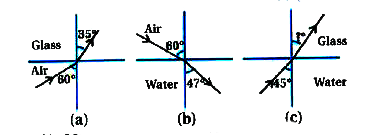Light ray travels from air to glass and air to water, as shown in figure (i) and (ii) respectively. What is refraction angle for figure (iii) ?
 Solution in Gujrati
Solution in Gujrati
30∘
35∘
60∘
41∘
The correct Answer is:B, C
aμg=sin60∘sin35∘ …......(1)
aμw=sin60∘sin41∘ …......(2)
wμg=sin41∘sinθ∘ …......(3)
aμg=aμw×wμg
sin60∘sin35∘=sin60∘sin41∘×sin41∘sinθ
∴sinθ=sin35∘
∴θ=35∘
Topper's Solved these Questions
- RAY OPTICS AND OPTICAL INSTRUMENTSBook:KUMAR PRAKASHANChapter:RAY OPTICS AND OPTICAL INSTRUMENTSExercise:SECTION-D (MULTIPLE CHOICE QUESTIONS (MCQs))(MCQs FROM .DARPAN. BASED ON TEXTBOOK)(TOTAL INTERNAL REFLECTION)
Explore 14 Videos
- RAY OPTICS AND OPTICAL INSTRUMENTSBook:KUMAR PRAKASHANChapter:RAY OPTICS AND OPTICAL INSTRUMENTSExercise:SECTION-D (MULTIPLE CHOICE QUESTIONS (MCQs))(MCQs FROM .DARPAN. BASED ON TEXTBOOK)(REFRACTION, MAGNIFICATION, POWER AND COMBINATION OF LENS)
Explore 29 Videos
- RAY OPTICS AND OPTICAL INSTRUMENTSBook:KUMAR PRAKASHANChapter:RAY OPTICS AND OPTICAL INSTRUMENTSExercise:SECTION-D (MULTIPLE CHOICE QUESTIONS (MCQs))(MCQs FROM .DARPAN. BASED ON TEXTBOOK)
Explore 26 Videos
- MOVING CHARGES AND MAGNETISMBook:KUMAR PRAKASHANChapter:MOVING CHARGES AND MAGNETISMExercise:SECTION D (MCQs ASKED IN COMPETITIVE EXAMS)
Explore 34 Videos
- SAMPLE QUESTION PAPER Book:KUMAR PRAKASHANChapter:SAMPLE QUESTION PAPER Exercise:PART-B SECTION-C
Explore 5 Videos
Similar Questions
When light ray travels from ...... then total internal reflection is possible.
View SolutionLight rays emerge from denser medium (n2), refract from curved surface and then travel through rarer medium (n1), formula for this is ….........
View SolutionDiameter of spherical mirror is 10 cm, what will be aperture of mirror ?
View SolutionElectric charge Q having mass M moves on a circular path of radius R with velocity →v, perpendicular to uniform magnetic field B. When a particle completes one revolution, work done by the field is _______
View SolutionTwo charges –q and +q are located at points (0, 0, –a) and (0, 0, a), respectively.
(a) What is the electrostatic potential at the points (0, 0, z) and (x, y, 0) ?
(b) Obtain the dependence of potential on the distance r of a point from the origin when r/a>>1 .
(c) How much work is done in moving a small test charge from the point (5,0,0) to (–7,0,0) along the x-axis? Does the answer change if the path of the test charge between the same points is not along the x-axis?
View SolutionA ray of light is travelling from glass to air. The angle of incidence in glass is 35∘, and angle of refraction in air 60∘. What is the refractive index of glass w.r.t. air ?
View SolutionA ray of light is travelling is travelling from air to water. What is the angle of incidence in air, if angle of refraction in water is 41^(@) ? Take refractive index of water = 1.32 .
View SolutionGlass has refractive index μ with respect to air and the critical angle for a ray of light going from glass to air is θ. If a ray of light is incident from air on the glass with angle of incidence θ, the corresponding angle of refraction is
View SolutionRefraction of light from air to glass and from air to water are shown in figure (i) and figure (ii) below. The value of the angle θ in the case of refraction as shown in figure (iii) will be

View SolutionA light ray is travelling from air to glass. True reflected and refracted rays are perpendicular to each other. If the angle of incidence in air is I the refractive index of glass is
View SolutionA ray of light travels from air to glass . It is found that the angle of refraction is half the angle of incidence . Then the angle of refraction is given by
View SolutionA ray of light travelling from air to glass is deviated by an angle of 24∘. If the reflected and refracted rays are at right angles then the angles of incidence is
View SolutionFind the angle θa made by the light ray when it gets refracted from water to air, as shown in figure.

View SolutionA ray of light is travelling from glass to air (Refractive index of glass = 1.5).The angle of incidence is 50^(@) .The deviation of the ray is
View SolutionFigures (a) and (b) show refraction of a ray in air incident at 60∘ with the normal to a glass-air and water-air interface, respectively. Predict the angle of a refraction in glass when the angle of incidence in water is 45∘ with the normal to a water-glass interface .

View Solution